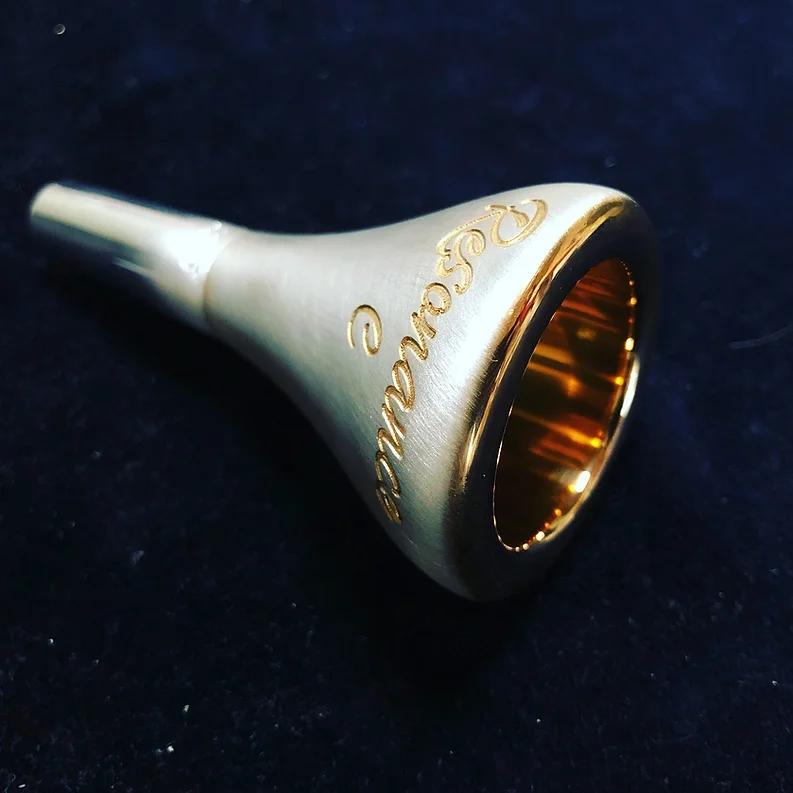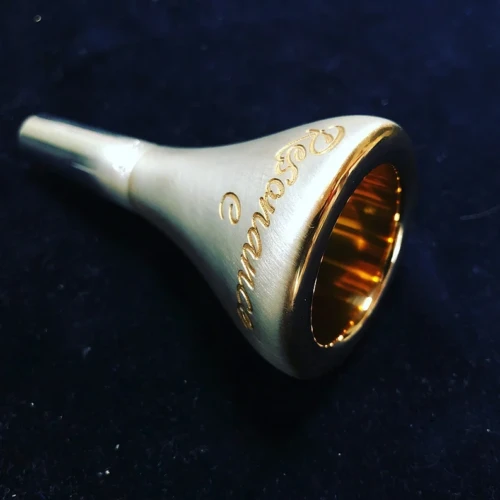AR Resonance trombone mouthpieces

AR Resonance is run by Antonio Rapacciuolo in Nole, Italy. He produces high end trumpets and flugelhorns and mouthpieces for trumpet, trombone, tuba and euphonium. Saying he produces simple mouthpieces is quite an understatement. Check out his custom works here and you’ll agree with me – he produces works of art!
All trombone mouthpieces are two piece mouthpieces consisting of a mouthpiece top and a backbore. In the Swisstbone shop you’ll find complete mouthpieces with the most popular options. But if you want to order only a particular backbore, don’t hesitate to contact me about it.
As of March 2024 all our AR Resonance mouthpieces are shipped from France by my partner Robin Rinchard.
Materials
AR Resonance goes beyond the ordinary with its unique mouthpiece materials, each offering distinct characteristics for your playing style. Here’s a breakdown to help you find your perfect match:
Brass: The classic choice, familiar and comfortable, offering the sound you expect. AR Resonance’s design elevates these mouthpieces for exceptional feel and performance.
Bronze: Compared to brass, bronze boasts a faster response, richer resonance, and more defined notes. Some describe it as darker in the lower and middle registers, but it brightens beautifully in the highs when pushed. It also enhances articulation and feels effortless to play.
Nickel Silver: The speed king (except for buffalo horn), nickel silver offers a full body and bright sound. The lightning-fast response makes clean articulation a breeze. No wonder it’s Sergei Nakariakov’s material of choice!
Stainless steel: This material delivers a darker sound with less perceived articulation for the player. However, from a distance, it projects a clear and piercing tone with crisp articulation. It excels in forward projection, but has less side presence.
Titanium: Feather-light and extremely responsive, titanium reduces fatigue and offers a bright, metallic sound (lighter than stainless steel). It’s also hypoallergenic, making it a great choice for those with allergies.
Buffalo horn: This exotic material, crafted from actual buffalo horn, is incredibly light, extremely durable, and boasts the fastest response and cleanest articulation. It delivers a woody sound at lower volumes and transforms into a laser beam of power on high notes. Perfect for lead players and those in cold climates, its grippy surface smooths out with a dip in olive oil (yes, you read that right!).
Damasteel: For those seeking a luxurious touch, Damasteel offers a particular Swedish steel with a stunning, two-toned pattern. While its sound and feel mirror stainless steel, its visual impact is undeniably cool.
Sizes
AR Resonance’s numbering system is a little different than what you might be used to from other brands. However, once you get the hang of it, it’s quite simple and effectively showcases the different options available. Here’s my attempt at explaining the system, along with a comparison chart to give you a good idea of what sizes might fit you.
Rims and Cups
On the “Classic” tenor trombone mouthpieces, the names simply correspond to the rim size. So, “25.1” denotes a mouthpiece with a rim size of 25.1mm. You can choose between a standard cup or a more V-shaped cup (called V+). These mouthpieces are available in small shank or large shank and with a 6.00mm or 6.5mm throat.
On the Symphonic tenor trombone mouthpieces, the rim sizes are similar to clothing sizes (XL, L, M, etc.). All have a large shank and a 7.2mm throat, reflected by the “72” in their name. Here’s a breakdown of the rim sizes:
XL = 27.20mm
VL = 26.80mm
L = 26.40mm
ML = 26.00mm
M = 25.60mm
MS = 25.20mm
S = 24.80mm
Therefore, if you order an “S72” cup, you’ll receive a 24.80mm rim with a symphonic cup and a 7.2mm throat.
The same system applies to the bass trombone; simply add a “B” before the size letter. Available sizes are:
BVL = 28.80mm
BL = 28.40mm
BM = 28.00mm
BS = 27.60mm
Bass trombone mouthpieces have an 8.0mm throat and a deep U-shaped cup.
Generally speaking, AR Resonance’s cups and rims fall within a “middle-of-the-road” range. The real customization lies in the backbore and its transition to the throat. This is where Antonio’s ingenuity shines, allowing you to truly personalize the feel of your mouthpiece.
Backbores
Classic Tenor Trombone: You can choose between small, medium, or large backbores, ranging from the most tightly constricted to the most open. This is also where you choose your 6.0mm or 6.5mm throat size.
Symphonic Tenor Trombone: All backbores come with a 7.2mm throat. Again, they range from the smallest to the biggest:
GR0: The smallest backbore, ideal for soloists or those needing extra power in the high register.
GR1: The standard choice for first trombonists, offering support in the high register without being too restrictive.
GR2: Slightly more open, resulting in a fuller sound. A good choice for second trombone or players seeking a darker sound.
GR3: A particularly open backbore, well-suited for third trombone players or those who also play bass trombone.
Bass Trombone: All backbores have an 8.00mm throat.
GR0: Offers some tightness, providing support in the high register.
GR1: A good all-rounder, likely the starting point for most bass trombonists.
GR2: More open, promoting a full-bodied sound.
GR3: Very open, ideal for playing low and loud.
I hope this explanation helps you to understand AR Resonance’s numbering system!
